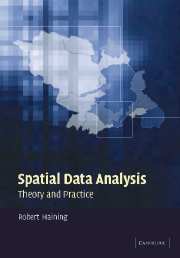Book contents
- Frontmatter
- Contents
- Preface
- Acknowledgements
- Introduction
- Part A The context for spatial data analysis
- Part B Spatial data: obtaining data and quality issues
- Part C The exploratory analysis of spatial data
- 5 Exploratory spatial data analysis: conceptual models
- 6 Exploratory spatial data analysis: visualization methods
- 7 Exploratory spatial data analysis: numerical methods
- Part D Hypothesis testing and spatial autocorrelation
- Part E Modelling spatial data
- Appendix I Software
- Appendix II Cambridgeshire lung cancer data
- Appendix III Sheffield burglary data
- Appendix IV Children excluded from school: Sheffield
- References
- Index
7 - Exploratory spatial data analysis: numerical methods
Published online by Cambridge University Press: 06 July 2010
- Frontmatter
- Contents
- Preface
- Acknowledgements
- Introduction
- Part A The context for spatial data analysis
- Part B Spatial data: obtaining data and quality issues
- Part C The exploratory analysis of spatial data
- 5 Exploratory spatial data analysis: conceptual models
- 6 Exploratory spatial data analysis: visualization methods
- 7 Exploratory spatial data analysis: numerical methods
- Part D Hypothesis testing and spatial autocorrelation
- Part E Modelling spatial data
- Appendix I Software
- Appendix II Cambridgeshire lung cancer data
- Appendix III Sheffield burglary data
- Appendix IV Children excluded from school: Sheffield
- References
- Index
Summary
This chapter continues with exploratory spatial data analysis (ESDA) and discusses numerical methods. Section 7.1 reviews methods for smoothing graphs and map data. The aim of map smoothing is to remove distracting noise or extreme values present in data in order to reveal spatial features, such as trends, or ridges or zones of rapid transition in the data (Kafadar, 1999). Map smoothing is important where data values are known to be of low as well as varying precision (perhaps due to aggregation effects). In statistical terms, map smoothing involves trying to improve the precision associated with such data values whilst not introducing bias. Map smoothing may also help suggest covariates for subsequent statistical modelling of the data.
The remaining sections consider methods that involve hypothesis testing so that now the data are assumed to come from some generating model (see section 2.1.4). Section 7.2 reviews tests for detecting an overall tendency for similar values to be found near together on a map (‘whole map’ clustering or spatial autocorrelation). Section 7.3 discusses tests for detecting clusters (‘localized’ clustering). Hypothesis testing is used to identify which clusters or concentrations of an event are statistically significant. Hypothesis testing is used as an aid to sifting out potentially interesting areas of the map. The tests are exploratory in that a null model is proposed and test statistics are constructed to enable a decision to be reached as to whether to retain the null hypothesis or reject it in favour of some general non-specific alternative.
- Type
- Chapter
- Information
- Spatial Data AnalysisTheory and Practice, pp. 226 - 270Publisher: Cambridge University PressPrint publication year: 2003
- 1
- Cited by



